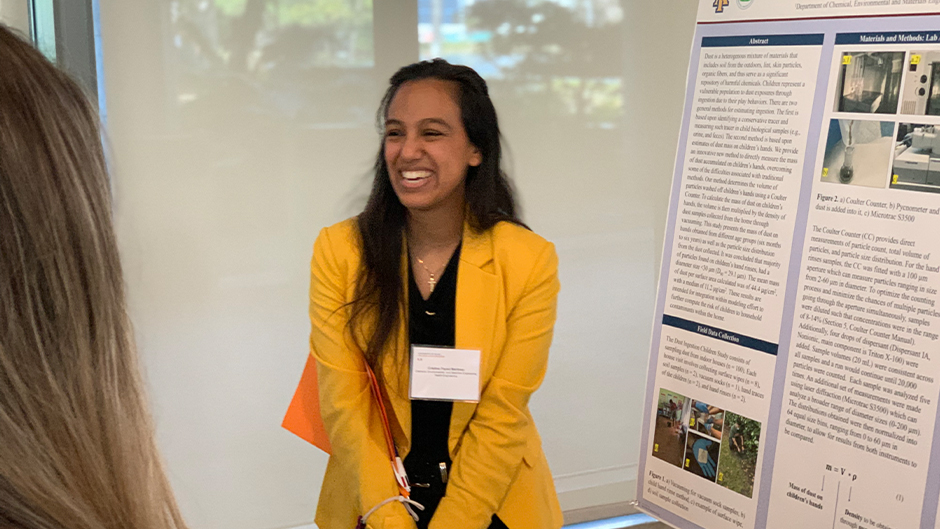The College of Engineering showcased its Ph.D. students’ groundbreaking research at Engineering Research Day on March 2, 2023.
“Our faculty and students work together to produce stunning breakthroughs,” said Pratim Biswas, dean of the College of Engineering. “This event highlights our students’ work toward the strategic initiatives guiding research at the College.”
Students presented 68 posters across three sessions at the Lakeside Village Expo Center–offering participants a kaleidoscopic vision of College of Engineering research.
“Engineering Research Day is when the college shines through its students,” said Fabrice Manns, associate dean of research, professor and chair of the Department of Biomedical Engineering. “Participants see the breadth and depth of boundary-breaking research happening at the College.”
Chaos engineering
Austin Perry, mentored by Esber Andiroglu, associate professor of professional practice in the Department of Civil and Architectural Engineering, introduced the concept of chaos engineering.
“Chaos engineers can design interventions that save lives in chaotic environments like disaster scenarios,” Perry said. “For example, plane crash survivors often act erratically during an evacuation, obstructing the aisle by prioritizing grabbing their carry-on luggage from overhead bins instead of focusing on exiting the aircraft. Chaos engineers, in this example, would design a button the pilot could press that would lock the overhead bins, preventing the desire to get your luggage and blocking the aisles.”
Chaos engineers try to anticipate the range of behaviors a person can exhibit in dangerous situations to engineer interventions that minimize negative decisions and facilitate the maximum number of positive outcomes. “Our intervention ideally refocuses your effort on what the priority should be – evacuating,” Perry added. “We hope these types of interventions make various chaotic situations easier to navigate for the average person, saving lives.”
Dust ingestion
Cristina Fayad Martinez presented research supported by the EPA investigating children’s exposure to dust in the household. “We found that dust ingestion varies widely depending on age and location,” said Martinez, mentored by Helena Solo-Gabriele, professor in the Department of Chemical, Environmental, and Materials Engineering, “after conducting house visits in Miami, Florida, Greensboro, North Carolina, and Tucson, Arizona.
“Due to hygiene habits learned with age, children 3-6 years old had significantly less dust on their hands than children 6-12 months old,” she said. “We also found that children in Tucson had the greatest exposure to dust while children in Miami had the least.”
Bioaerosols
Nohhyeon Kwak presented research on how rain can influence the levels of aerosols and bioaerosols near livestock farms, highlighting potential health concerns for farm workers and neighboring residents. “An aerosol is basically any particle that is suspended in the air,” he said, “and bioaerosols specifically are particles in the air that come from biological sources–think viruses, bacteria, animals, fungi.”
His research group, mentored by Jiayu Li, assistant professor in the Department of Mechanical and Aerospace Engineering, found that rain reduced the concentration of aerosol near livestock farms, but increased the fraction of bioaerosols, potentially due to increased fungal activity.
“Looking ahead,” he said, “we want to determine the species of bacteria that become more prevalent after rain. Studies in the future will focus on viruses and fungi.”
3D printing
Raden Gustinvil, mentored by Emrah Celik, associate professor in the Department of Mechanical and Aerospace Engineering, presented research on new materials that show improved efficiency and sustainability in 3D printing.
“Copper sulfide,” he said, “is a cheaper, non-toxic semiconductor material that can sustain higher temperatures than traditional thermoelectric materials. This means that we can make 3D printed modules more versatile by using this material, producing objects that can stand up to more wear-and-tear in real-world applications.”
Aerosols and astronaut safety
Shruti Choudhary, mentored by Biswas, presented research on how aerosol science may lead to safer working conditions for astronauts and, in the future, safer human habitation on the moon.
“Real time lunar dust characterization in cabins and gateways remains a challenge,” Choudhary said. “The objective is to develop an advanced sensor with the capability of particle characterization and size distribution measurements.”
Nuclear fusion
Inam Iqbal Lalani, mentored by Giacomo Po, assistant professor in the Department of Mechanical and Aerospace Engineering, presented research on the potential use of tungsten to build nuclear fusion reactors.
“You can’t afford to make mistakes when dealing with nuclear energy,” Lalani said, “so intense modeling and research is essential to determining if tungsten is the best material in this case. If scientists get nuclear fusion right, we may be able to create unlimited energy, solving the current energy crisis.”
The team is using discrete dislocation dynamics (DDD) to understand how tungsten reacts to extreme heat. “Using DDD, we’re able to model how the atoms in tungsten move around under nuclear fusion conditions. This helps us understand if the material would be able to sustain decades of use.
Using nanoindentation and high-temperature micropillar compression, the team is performing cutting-edge tests with instruments that are hard to come by. “We have personally developed the experimental methodology with scientists from UCLA and are responsible for troubleshooting, calibrating, and pushing boundaries for experimental analysis of the mechanical characterization of materials. This huge development has enabled us to bring forward new discoveries with respect to nuclear fusion energy and then our simulations will explain them at the most fundamental atomic level.”

